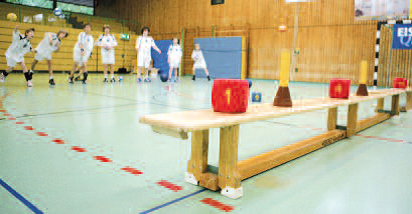- New tools in the service of everyday physical education
- The jumping-rope exercises
- The extension and adaptation of the corrective exercises utilizable within the limits of everyday physical education – and compiled by MGT – for physical education classes
- 1. Practice test: the examination of the relationship between the standing position and squats in terms of strength and flexibility.
- 6. Practice test: testing the strength of the stretching muscles of the thighs
- 2. Practice test: testing the strength and flexibility of the shoulder and pectoral (shoulder) griddle muscles
- 3. Practice Test: Testing the strength of deep back muscles and hip flexors
- 4. Practice test: testing the strength of the abdominal muscles from the top.
- 5. Practice test: testing the strength of the abdominal muscles from the bottom.
- 7. Practice Test: testing the flexibility of the lumbar spine to bend forward
- 8. Practice Test: testing the capacity of the lumbar spine to bend backwards
- 9. Practice Test: testing the twisting capacity if the lower back and lumbar spine
- 10. Practice test. Testing the thigh and lower leg back muscles
- 11. Practice Test: testing the flexibility of the hip flexors
- 12. Practice Test: testing the stretching capacity of the hip joint
- References
- Ballkorobics – a new form of movement in the palette of physical education
- Methods of continuous (non-stop) instruction
- The balance disc
- Balance exercises with a Fit-ball
- Strengthening exercises with a gymnastic ball
- Functional training
- Crossfit
- Background and the legal context of the introduction of everyday physical education
- Changes in the physical education in schools, a short history of everyday physical exercise and physical education
- The background to the introduction of everyday physical education
- The introduction of everyday physical education
- The tasks resulting from the introduction of everyday physical education
- Online readings
- References
- Minitrampolin
- Progressive Step and gymnastics box exercises
- Dance Education
- Versatile usability of the devices of kids’ athletics in physical education classes
- The color throw ball (100 items)
- The ring
- The disc cone marker
- Team vests (6x10 items – 6 colors)
- The coordination ladder
- The foam hurdle (children’s hurdle)
- The numbered discs
- The foam javelin and plastic javelin
- The disc
- The Catch Tail Ball
- The numbered mat
- The jumping-rope
- The foldable gymnastics mat
- The medicine ball
- Soft ball handball
- Handling and catching the ball
- Passes
- Shooting on goal
- Games applying the technical elements and rules of handball
- References
Throwing on target game

Source: http://www.ihf.info/files/Uploads/Documents/10285_Booklet_en.pdf
We form two teams. In the centre of the playing field we put a bench with various objects on its surface, we mark the base lines at equal distance in both directions, and the two teams line up there (we can put benches at the base lines too). The members of one of the teams have the soft balls, and they aim at the objects on the bench at a given sign. They score as many points as many objects they manage to throw off the bench. Then we put the objects back, and the other team gets the soft balls. The winner is the team that score more points after an equal number of attempts. It can also be played in a way that the teams aim at the same time, and the game is over when every object falls off the bench. Then we count which team has managed to hit more tools.